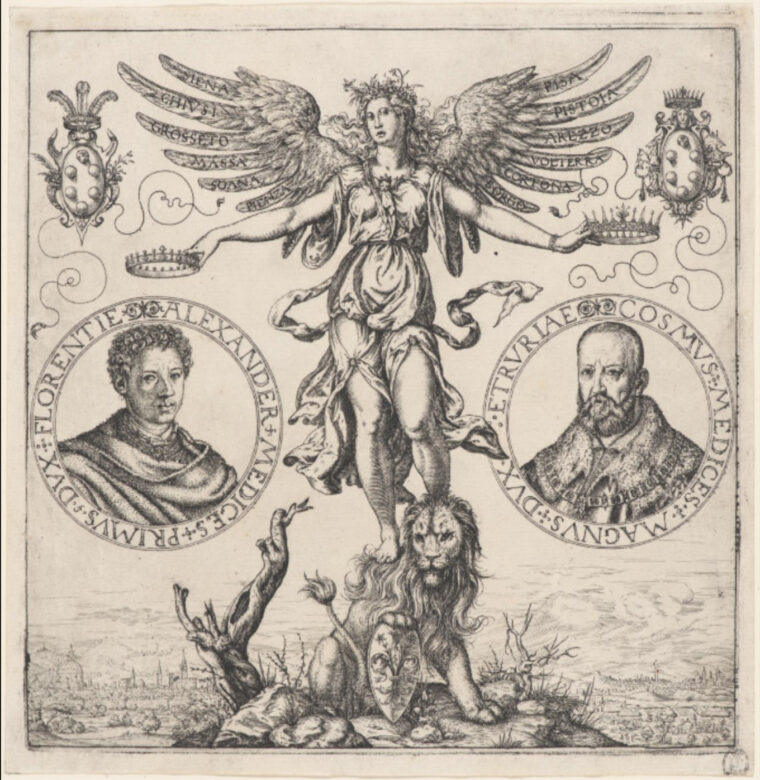Davison Art Center Lends Rare 16th-Century Print to the Met


It’s common today to speak of building one’s brand—everyone from world leaders to precocious teens are worried about their image, shaping their personalities online, creating a persona that straddles reality and the imagined.
For the Medici family, the 16th-century rulers of Florence and Tuscany and patrons of some of the most famous Renaissance artwork, the tools to accomplish this were very different from those of today. However, the objective was the same.
Wesleyan’s Davison Arts Center (DAC) is participating in an exhibition at the Metropolitan Museum of Art called “The Medici: Portraits and Politics, 1512-1570,” currently on display through October 11. The exhibition pulls together more than 90 works, including portraits, engravings, busts, medals, and armor, to describe the rise to power of the Medici family after a period of exile, and to show how they used culture to shape public perception.
The DAC is lending a rare 16th-century print commemorating Medici rule over Tuscany. The Met requested the work in early 2020.
“I find this stuff endlessly fascinating. It’s amazing how these fragile pieces of paper, and all art work, survive across the centuries. To be able to work with these [works] and share them with students and the public is something I am really grateful for,” said Miya Tokumitsu, curator of the Davison Art Center.
The DAC’s contribution to the exhibit is a 7.2-by-7-inch print—essentially a piece of political propaganda. Impressions of this particular print, made in honor of the ascension of Cosimo I de’ Medici to power, could have been passed from person to person, pasted inside books, or given as gifts, said Tokumitsu. Distribution of engravings like this one was a way that people of the time period would experience major works of art—and the persuasion efforts of their leaders. “This print is small enough that it could’ve been displayed in a variety of ways,” she said.
The iconography of the print is extremely specific and tells a particular story of political power. “It takes a side. It is very pro-Medici, unapologetically and unambiguously so,” Tokumitsu said.
The goddess Flora, the personification of the city of Florence, dominates the print, her wings inscribed with the names of the Tuscan towns united under Medici rule.
Flora crowns two rulers’ portraits. Alessandro de’ Medici, the first duke of Florence, is depicted on the left against the background of Florence. His successor Cosimo I de’ Medici is shown on the right, described in the print as the “Grand Duke of Tuscany,” with an elaborate grand-ducal diadem held above him. Cosimo is set above the landscape of Siena, the last of the rebellious towns to fall to the Medicis.
Read properly, the engraving makes it clear to the viewer who is the rightful ruler of Florence: “Thus, it is Cosimo who truly merits the title of grand duke of Tuscany, for it was he who had finally united Tuscany under Medici rule,” according to the exhibition’s catalog.
“It uses all kinds of strategies—allegory, personification, portraiture, landscape, heraldry. (Engraver Martino) Rota plays every card,” said Tokumitsu.
So, what is the modern equivalent of this print? One possibility is the famous Shepard Fairey print of Barack Obama featuring the word “Hope.”
“That’s a pretty good comparison,” Tokumitsu said. “Obviously we have a different political system—the Medici were hereditary dukes and we are in a modern democracy. But it’s kind of funny what doesn’t change. The portrait format in the Obama image—it’s a bust portrait, just like what we are looking at with Alessandro and Cosimo. That front bust portrait is an enduring format. It’s also a print, which I think is very important. It uses text in a very novel way. So, there are a lot of parallels. There’s something really enduring about the leader portrait.”
The Davison Art Center Collection is accessible online at the Davison Art Center Collection Search. Digital images of more than 6,000 out-of-copyright artworks are available for free direct download as high-quality JPEG or TIFF files.

